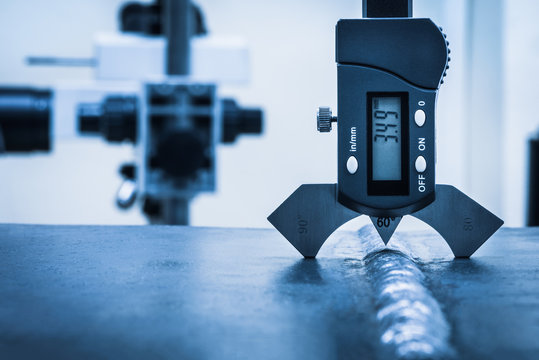Important Tips for Effective Welding Inspection Madison Solutions
Important Tips for Effective Welding Inspection Madison Solutions
Blog Article
The Significance of Thorough Welding Inspection in Industrial Applications
In the realm of commercial applications, the relevance of meticulous welding examination can not be overstated. It plays a crucial role in making sure the structural stability and longevity of welded components. Advanced non-destructive testing methods enable for the very early discovery of possible flaws, such as fractures and insufficient blend, which, if left untreated, might lead to disastrous failings. Adherence to strict industry standards not just assures high quality however additionally builds customer confidence. As we explore the diverse advantages of diligent welding evaluations, one should think about the broader ramifications on safety, reliability, and cost-effectiveness in industrial operations.
Enhancing Architectural Integrity
When it comes to welding evaluation in commercial applications, improving architectural stability is paramount. The main goal of welding assessment is to ensure that the welds are qualified of bearing the anticipated loads and tensions they will certainly come across in service.
The relevance of maintaining structural honesty in welded structures can not be overstated. Inadequately executed welds can lead to catastrophic failures, resulting in pricey repair services, downtime, and also endangerment of human lives. As a result, examiners play an important function in the lifecycle of commercial parts, offering assurance that the welding procedure delivers the desired stamina and durability.
Additionally, progressed modern technologies, such as phased selection ultrasonic screening and electronic radiography, offer improved capabilities in discovering potential weak points, allowing for restorative procedures before concerns escalate. By prioritizing the stability of welds with careful evaluation, sectors can make certain functional performance and expand the durability of their facilities.
Recognizing Welding Problems
Identifying welding defects is an essential facet of ensuring the safety and reliability of bonded frameworks. Usual welding flaws consist of porosity, splits, incomplete blend, and damaging.

Knowledgeable assessors use both aesthetic evaluation and advanced non-destructive screening (NDT) approaches, such as radiographic or ultrasonic screening, to identify these issues. The timely identification and correction of welding defects are vital to preserve the structural stability and durability of commercial components.
Making Sure Compliance Criteria
Conformity with well established requirements, such as those offered by the American Welding Society (AWS) and the International Organization for Standardization (ISO), ensures that welds fulfill minimal safety and security and top quality needs. These requirements include a vast range of criteria, consisting of material specs, welding treatments, and qualification of welders.
Routine audits and assessments are vital in confirming conformity. Assessors need to possess a thorough understanding of the relevant requirements and be skilled at using various non-destructive testing (NDT) techniques to evaluate weld high quality. By ensuring that welding practices straighten with compliance requirements, companies alleviate the threat of non-conformity, which can bring about lawful obligations and safety dangers.
Moreover, keeping conformity not only safeguards structural integrity however also improves a business's track record in the market. Stakeholders and clients are most likely to count on companies that constantly demonstrate a dedication to top quality and security through extensive compliance. Therefore, making sure compliance criteria is an important part in the effective application of welding in industrial applications.
Reducing Upkeep Expenses
The application of innovative non-destructive screening (NDT) techniques, including ultrasonic, radiographic, and magnetic fragment evaluations, improves the ability to find subsurface defects without endangering the architectural stability of components. By employing these strategies, industries can considerably extend the service life of their devices, minimizing downtime and the associated economic problem of upkeep activities.
Furthermore, a durable welding assessment program supports the optimization of maintenance schedules, changing from responsive to anticipating upkeep strategies. This positive strategy not just stops unanticipated failings but additionally enhances resource appropriation, making sure that maintenance efforts are focused and reliable. Ultimately, the investment in extensive welding examination is balanced out by the considerable savings understood with reduced upkeep demands, adding favorably to the general functional efficiency of commercial ventures.
Improving Safety Steps
Although safety is a vital concern in commercial operations, achieving optimum safety requirements calls for a committed emphasis on the quality and dependability of welded structures. Welding examination plays a vital duty in this context, as it ensures that all connections like this and joints satisfy rigorous safety criteria. Comprehensive examinations assist recognize problems such as fractures, porosity, or incomplete blend that can jeopardize architectural stability. Such issues, if left unaddressed, present substantial dangers, possibly resulting in catastrophic failings.
Methods like ultrasonic testing, radiographic screening, and magnetic particle assessment enable for in-depth exam without damaging the framework. Carrying out a durable high quality control system that consists of normal training for assessors and welders makes certain adherence to established safety and security standards.
Last but not least, promoting a society of security within the company emphasizes the relevance of thorough welding evaluations. Motivating open interaction and collaboration amongst assessors, welders, and designers adds to a common dedication to safety excellence. Welding Inspection Madison. In doing so, markets can guard their operations, protect workers, and preserve public trust

Conclusion
Detailed welding inspection is essential linked here in commercial applications, dramatically enhancing structural honesty and reliability. Ultimately, the attentive execution of welding inspections plays an important duty in preserving operational effectiveness and safety and security in industrial setups.
As we check out the diverse advantages of thorough welding evaluations, one must consider the more comprehensive effects on safety and security, reliability, and cost-effectiveness in industrial procedures.
The main goal of welding assessment is to make sure that the welds are qualified of bearing the expected tons and stress and anxieties they will certainly run into in service. Reliable welding inspection plays an essential role in decreasing these prices by making look at here now certain the honesty and durability of welds, therefore alleviating the danger of premature failures.Extensive welding evaluation is important in commercial applications, dramatically improving structural honesty and reliability. Ultimately, the attentive execution of welding evaluations plays an important duty in keeping operational efficiency and safety and security in industrial setups.
Report this page